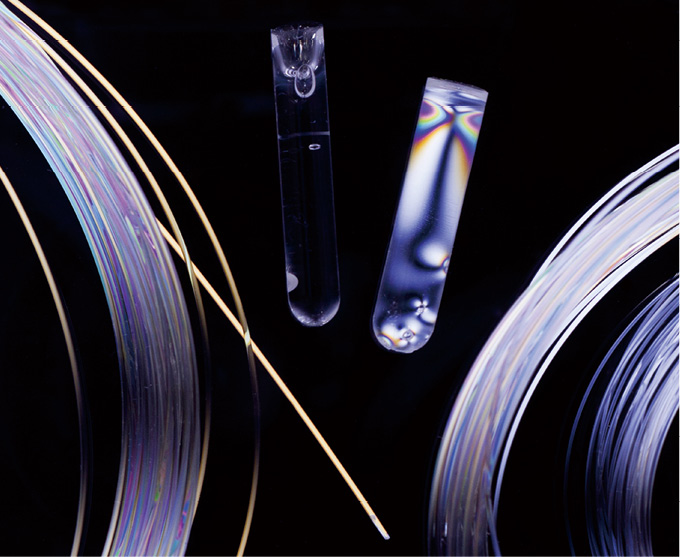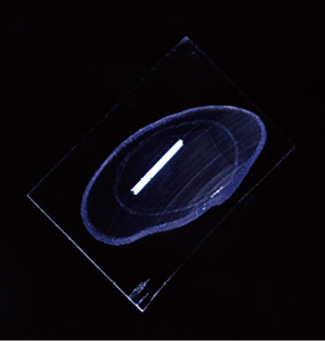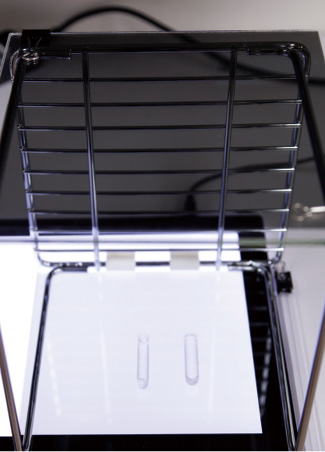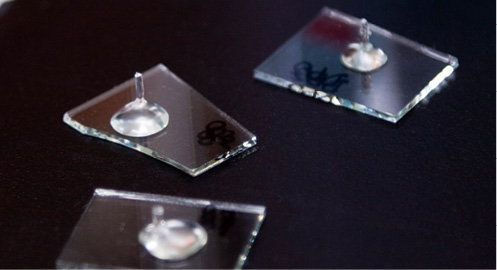OPAL-RING
Rei FURUKAWA Laboratory
Development of polymer optical fiber stress sensors
| Faculty/Department | Center for Frontier Science and Engineering |
|---|---|
| Members | Rei Furukawa, Assistant Professor |
| Affiliations | SPIE; Japan Society of Applied Physics; Society of Polymer Science, Japan |
| Website | http://www.fururei.com |
As of August, 2015

- Rei FURUKAWA
- Keyword
-
Optical fiber stress sensor, polymer optical fiber, multimode fiber
Summary of Research
Using Polymers to Develop Innovative Optical Fiber Stress Sensors
Optical fibers are used in the fields of optical communication and instrumentation as sensors that detect distortion, vibration, and temperature. Such sensors typically operate by correlating the degree of structural change induced in an optical fiber to the corresponding change observed at a specific wavelength of light passing through the fiber.
The main characteristics of these optical fiber sensors include ease of installation and speed of measurement. Additionally, the light transmission properties of optical fibers are remarkably resistant to external conditions ranging from temperature, humidity, vibration, and corrosion to electromagnetic radiation, ensuring the stability of the measured data. They also achieve superior resolution and durability, ideal for applications across a wide range of fields.
The sensors mentioned above have one key drawback: The optical fibers they incorporate are typically made of silica, the raw ingredient for glass, making them susceptible to breakage when subjected to kinking, bending, or impact. Silica also limits the maximum diameter of the optical fibers and requires the development of special techniques to receive light at the appropriate angles.
Current activities at our laboratory include research and development on stress sensing instruments based on polymer optical fibers to address these shortcomings. These fibers also exhibit reduced birefringence, the property of a material whereby the refractive index depends upon the polarized state of light. The use of plastic also allows the production of large-diameter optical fibers not achievable with silica. Polymer optical fibers exhibit higher resistance to bending and shock, allowing them to be embedded into roads, bridges, tunnels, building structures, and vehicles and vastly expanding the range of potential stress sensing applications.

- Polymer observed under cross-polarization. Anisotropic areas appear bright. In the center left is a polymer for which birefringence has been eliminated. In the center right is a normal polymer. The left and right bundles are polymer optical fibers.
Multimode Compatibility to Simplify Installation
Advantages
Tough and Resilient When Flexed
Conventional polarization maintaining (PM) optical fibers, or fibers that preserve the polarization state of light during transmission, are available only as single-mode silica fibers characterized by diameters of less than 10 μm. The Mach-Zehnder interferometer represents the most prominent example of sensors incorporating these conventional fibers. Measurements with this device are based on the interference produced between light beams traveling through a working (= stressed optical fiber) path and a reference (= stress-free optical fiber) path.
In contrast, the optical fibers developed at our laboratory with a fiber core of zero-birefringence polymer maintain polarization in multimode (capacity to simultaneously transmit multiple beams or modes), eliminating the need to use two optical fiber lines, as in the conventional Mach-Zehnder interferometer. This dramatically simplifies installation.
In silica optical fibers, the diameter of the high-refractive index core is limited to about 10.50 μm. The core of polymer optical fibers can be enlarged to up to 1 mm. Due to this large diameter, polymer optical fibers require less precision when positioning the elements at fiber-fiber connections or at junctions to light sources. Combined with their greater capacity to flex, bend, and stretch, these characteristics result in a structure resistant to damage caused by seismic motion or minor mechanical trauma. Damaged silica glass fibers can leak light. In contrast, polymer optical fibers can withstand significantly more damage before exhibiting adverse behavior.

- Polymer optical fiber being embedded into resin to observe birefringence
Cost Effectiveness
Polymer optical fibers offer another advantage over silica optical fibers: low cost. Silica optical fibers must be manufactured in furnaces at high temperatures. These procedures involve the consecutive drawing or spinning of a larger-diameter preformed fiber into thinner fibers. In contrast, like ordinary plastic, polymer optical fibers can be machine molded at relatively low temperatures. This reduces costs significantly at the mass production stage and turns on its head the conventional understanding that optical fibers are costly.
Applicability to Wide Range of Stress-Sensing Purposes from Buildings and Structures to Vehicles

- Cross polar observation
Conventional silica optical fibers require heat fusion splicing or adhesives during installation. Installing the new polymer optical fiber simply involves attaching them to connectors, just as with wire cables, opening up potential applications across a broad range of fields. The optical fibers used in stress sensor systems installed in cars and aircraft must be positioned along the inside wall of the frames, making flexibility a key requirement. This is yet another application where polymer optical fibers will prove invaluable.
Future Prospects
Measurement and Assessments of Aging Infrastructures, Buildings, Structures, and Automotive Applications Using Polymer Optical Fiber Stress Sensors
In December 2012, the Sasago Tunnel on the Chuo Expressway in Japan collapsed due to age. Such tragedies cannot be prevented by visual inspection alone, since visual inspection is poorly suited to detecting fatigue failure in concrete. On the other hand, thoroughgoing nondestructive inspections of such structures can pose extreme challenges. These are precisely the environments in which stress sensors based on the polymer optical fibers currently being developed at our laboratory will shine. We plan to validate our sensing technologies by installing them in actual vehicles and structures and to continue to refine them until they are capable of detecting such signs of aging. Polymer optical fiber applications offer vast promise.
Our hope is that the technologies developed at our laboratory will help expand the range of applications for polymer optical fiber.

